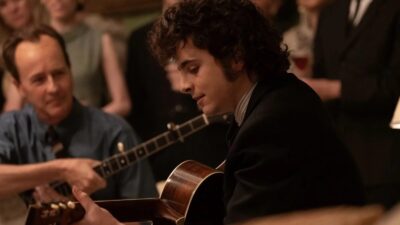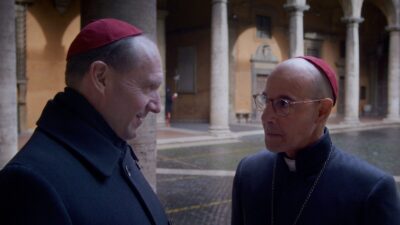This article previously appeared on Crossfader
Director: Kogonada
Genre: Drama, Romance
Year: 2017
The year is 1949. Four years have passed since the surrender of Japan to the Allied forces. A 46-year-old Yasujiro Ozu releases his domestic drama, LATE SPRING. In the lead role, a young Setsuko Hara plays a bachelorette whose father is urging her to go and get married. She doesn’t want to. She can’t imagine that her father could live a life without her endless support. Who would be there to take care of him? For a film made in the late ‘40s, LATE SPRING boasted a sentimentality that was all but absent in the cheap thrills presented by Hollywood. It was a film of cycles, coming to terms with them, and the healing powers of time.
Cue Kogonada. South Korean born, but faithfully indebted to the internal lamentations of Ozu’s oeuvre. He is an artist the likes of which we don’t see much of in contemporary cinema. A video-essayist and academic, he’s a staunch traditionalist. A practitioner of a cinematic style that has gone somewhat out of vogue in the indie scene. You won’t find flashy steadicam shots here or other excessive formalist tendencies. Kogonada is a naturalist through and through; a filmmaker who has studied the craft with a keen eye, and has spent a lifetime preparing his debut film. And in August of 2017, he finally unleashed COLUMBUS onto the world.

Doing Every Frame a Painting’s work for him
After Jin, a Korean-born man (played in a career-redefining performance by John Cho) arrives in Columbus, Indiana to look after his comatose father, he entangles himself in a relationship with Casey, a much younger girl. Through a common interest in the city’s architectural scene and analogous domestic tragedies, the two help each other overcome their inner demons. Jin struggles with his role as a son, as well as his masculinity as an Asian male. Casey needs to accept that moving away from her mother, a recovering drug addict, is not as earth-shattering as it sounds. Architecture is the power of healing, and in their quest to reconcile with these internal struggles, they get to learn about each other and the monolithic buildings that populate the film’s eponymous town.
And here’s the catch: that’s the best I can do at pitching a film like COLUMBUS to you. If you are in any way interested in Ozu, debut directors, or Asian-led romances, you’re probably going to see this one way or another. After all, it is a bewilderingly strong debut, a powerhouse accomplishment from a truly skilled auteur. It’s quiet, contemplative, but never boring. It is a film that wrings out the psyche of its deeply human protagonists like a wet towel. Unfortunately for the rest of you, there’s no catchy marketing I can do on Kogonada’s behalf. I mean, how does one pitch a romance set to the backdrop of Indiana’s architectural legacy? For what it’s worth, it’s delightfully charming, and boasts a unique visual beauty that we far too often ignore come awards season.

How stoked do you think architecture blogs were to finally be relevant when this dropped?
So let’s say you’re even somewhat interested in this film. Why does COLUMBUS tick like a finely tuned watch? Well, for starters, it is so aesthetically adroit. Countless films try to impress through camera movement, whether handheld or machinated dexterity. But COLUMBUS is in the ilk of an Edward Yang project. It is photographic. Each composition serves the buildings in the camera’s three-dimensional space just as much as it does the characters. And I mean three-dimensional quite seriously here. The way Kogonada understands the framing of background and foreground imagery is blissfully inspiring. A low-angle shot of a brick archway (you’ll know it when you see it) is easily the most exciting static shot I’ve seen all year. Take any still from COLUMBUS and frame it; you’d have an architectural gallery like few others.
But what’s truly fantastic is the way all of this neatly ties into the story Kogonada wants to tell. The copy-paste Ozu compositions are undeniable, as is the plot’s clever modernization of LATE SPRING’s narrative crux. There is a feminist thrust here that is wonderfully refreshing. Casey isn’t subordinate to her parents wishes; her life is in her own hands. Neither is she just an empty vessel for Jin to vent his emotions on. She’s a young, dreamy, passionate woman with two contradicting fantasies: being there for her mother, and leaving this drive-thru town. And Kogonada’s masterstroke is that neither trajectory is unreasonable. Jin thinks he can give Casey advice for what to do with her life, but despite their kinship on a personal level, their commitment to family is incomparable.

All this nuance is captured through the gestures and stillness of Kogonada’s filmmaking. Just like LATE SPRING, it is about accepting our place in a perpetually changing world and making sense of what surrounds us, whether inanimate or not. It is about transparency, and how the truth is hard to swallow. COLUMBUS uses its postmodern architecture as a foundation for the subtlety of its narrative. It’s made a little too obvious when Casey challenges her mother by discussing the “subtlety” of her cooking, but that’s easily forgiven when the greater picture is so refined. The way Kogonada’s sound design utilizes the movement of vehicles as background noise perfectly encapsulates the identity of Columbus, Indiana. Just because nobody cares to park their car here doesn’t mean there isn’t something to see.
Verdict: Recommend















Comments